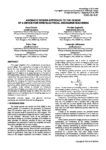
|
Axiomatic Design Approach to the Design of a Device for Wire Electrical Discharge Machining
Dodun, Oana, Petru Duşa, Nicolae Seghedin, and Laurenţiu Slătineanu
8th International Conference on Axiomatic Design, 2014
This paper presents a few considerations concerning to
product design. As an application, it focuses on the study of a
device that was designed to improve the material removal
process in wire electrical discharge machining. The main
objective of the research is to assess the device in the light of
the independence axiom of Axiomatic Design. The device was
intended for the experimental study of the material removal
process. The functional requirements concern essentially to
the ability for changing the machining process input factors,
the device adaptability to a specific machine tool and the usual
economics, safety, reliability, and easy-to-repair requirements.
The problem under analysis is focused on functional
requirements and design parameters and the results show that
the principles of axiomatic design are valid in the case of the
designed device and highlighted some interesting aspects to be
addressed in future research.
|
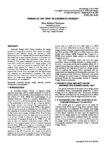
|
Where Is the ‘Why’ in Axiomatic Design?
Thompson, Mary Kathryn
8th International Conference on Axiomatic Design, 2014
Axiomatic Design (AD) Theory describes the design process as a mapping of ‘what’ to ‘how’ across four design domains. Every decision during this process is made deliberately, from the highest-level functional requirements to the lowest level process variables. However, it is unclear how and where to document that information within the AD framework. This paper investigates where and how the goals, motivation, values, and rationale of a design project – the ‘why’ – are, could, and should be specified within AD. It presents three options for where to find the goals and motivation (the highest-level ‘why’) of a design project. It explores the various ‘whys’ associated with the requirements and mapping and decomposition processes. The design domains are then viewed as a whole and a new model that defines the relationship between ‘why,’ ‘what,’ and ‘how’ information in AD is presented.
|
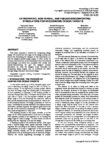
|
Extroverted, Non-Verbal, and Pseudo-Discomforting Stimulators for Recognizing Design Targets
Nakao, Masayuki, Satoshi Nakagawa, and Kenji Iino
8th International Conference on Axiomatic Design, 2014
This paper proposes a method for recognizing design targets. We looked into the origin of the design process and found that stimulating the designer to feel discomforts can help the designer identify design targets. In other words, we propose extroverted (to receive stimulation from the external surroundings), non-verbal (not expressed with words), and pseudo-discomforting (to give the designer anxiety) stimulators (to make the designer excite internally) for recognizing design targets, and we confirmed the effect through design education and product design.
|
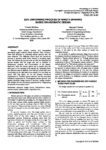
|
Size Uniforming Process of Minute Spheres Based On Axiomatic Design
Rikihisa, Hiroaki and Masayuki Nakao
8th International Conference on Axiomatic Design, 2014
Modern micro droplet reactors and nanoparticle processing require uniform minute spheres. They, however, often face difficulty in collecting minute spheres with the same diameter. The difficulty comes from the bottom-up process of growing small seeds, instead of breaking larger ones. The bottom-up process ends up with the byproduct of spheres smaller than the target size due to variation in temperature, pressure, and concentration of the system. Moreover, when the minute sphere size is smaller than the filter pore or the opening of the pipette tip, separating them into different sizes is difficult. One will have a hard time even in selecting out the right sized ones visually. For our study we report with this paper, we set the primary functional requirement to “Produce minute spheres” and the secondary functional requirement to “Homogenize minute spheres” and applied axiomatic design theory to develop a design solution that satisfies the two functional requirements by “suppressing the growth of secondary cores.”
|
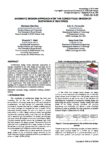
|
Axiomatic Design Approach for The Conceptual Design Of Sustainable Buildings
Marchesi, Marianna, Dominik T. Matt, John E. Fernandez, and Sang-Gook Kim
8th International Conference on Axiomatic Design, 2014
Architectural design needs systematic approaches to manage complexity in the early design process stage and to address sustainable building requirements. Architects often use previous experiences and knowledge to stimulate the early conjecture of possible solutions repeatedly until a satisfactory solution is defined. Possible use of an engineering design framework such as Axiomatic Design (AD) is studied with a case study on a small sustainable house design. High-level requirements are defined and decomposed into a manageable set of requirements. This study shows the potentialities of applying AD to support the initial architect’s decision-making activity for the development of sustainable solutions.
|

|
Application of Axiomatic Design to Electric Bicycles
Kreuzer, Andreas, Bernhard Nitsche, and Jussi Kantola
8th International Conference on Axiomatic Design, 2014
Market conditions and the situation inside electric bicycle producing companies require a product development process which ensures that customer requirements are met and problems in product design are identified at an early stage. Therefore, this research takes an analytical approach towards the development of electric bicycles by applying Axiomatic Design, which offers both a holistic framework for product development as well as analytical mapping in between the individual steps of the design process. The application is done as a case study at a German electric bicycle manufacturing company and based on a collection of customer feedback as well as the contribution of the company’s management. In the design process, functional requirements and design parameters are formulated and a design matrix is created to identify and resolve coupling issues. Further, constraints such as price, weight and ease of use are taken into account and process variables for practical implementation are suggested. The study results in recommendations for a specifications sheet of a new electric bicycle model. It is concluded that Axiomatic Design is of substantial advantage to the case company’s product development. Future research is suggested to improve the level of detail and quality of electric bicycles designed by Axiomatic Design.
|

|
Axiomatic Design Principles in Teaching Manufacturing Technology Design – Preliminary Approach
Slătineanu, Laurenţiu, Oana Dodun, Nicolae Seghedin, Margareta Coteaţă, Irina Beşliu, and Lorelei Gherman
8th International Conference on Axiomatic Design, 2014
The future specialists in the field of manufacturing technologies of mechanical equipments must have adequate knowledge about the possibilities to design and materialize the manufacturing processes. In order to fulfill this requirement, the university curricula include activities in which the students learn to design manufacturing technologies for various parts. Since one is talking about a design problem, one can formulate the question of applying the principles of axiomatic design (AD) for approaching and developing the design of manufacturing processes. The analysis of the stages corresponding to designing manufacturing processes facilitated the definition of the functional requirements. Solutions for approaching these stages were considered as design parameters. The initial analysis showed that a coupled matrix corresponds to the current way of designing manufacturing processes. Some investigations were developed in order to remove the use of the same design parameters for many functional requirements. An uncoupled matrix was thus elaborated and some remarks were formulated in order to find better solutions for design of manufacturing process.
|
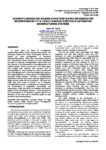
|
Axiomatic Design and Design Structure Matrix Measures for Reconfigurability & Its Key Characteristics in Automated Manufacturing Systems
Amro M. Farid
8th International Conference on Axiomatic Design, 2014
In recent years, the fields of reconfigurable manufacturing systems, holonic manufacturing systems, and multi-agent systems have made technological advances to support the ready reconfiguration of automated manufacturing systems. While these technological advances have demonstrated robust operation and been qualitatively successful in achieving reconfigurability, limited effort has been devoted to the measurement of reconfigurability in the resultant systems. Hence, it is not clear 1.) to which degree these designs have achieved their intended level of reconfigurability 2.) which systems are indeed quantitatively more reconfigurable and 3.) how these designs may overcome their design limitations to achieve greater reconfigurability in subsequent design iterations. Recently, a reconfigurability measurement process based upon axiomatic design and the design structure matrix has been developed. This paper now builds upon these works to provide a set of composite reconfigurability measures. Among these are measures for its key characteristics of integrability, convertibility, and customization, which have driven the qualitative and intuitive design of these technological advances. These measures are then demonstrated on an illustrative example followed by a discussion of how they may be practically applied in large automated manufacturing systems.
|

|
A Review on Information in Design
Puik, Erik, and Darek Ceglarek
8th International Conference on Axiomatic Design, 2014
Independence of design, information and complexity are the basic concepts of Axiomatic Design. These basic concepts have proven to be generic; axiomatic design was successfully applied in many markets and on a broad range of products and services. Information, or entropy, plays a central role in Axiomatic Design. In this paper an attempt is made to organise the different kinds of information, understand them, and evaluate the consequences of the ways they can be applied. A number of six kinds of information are reduced to two most determining kinds of information for the design. Unorganised information is about choosing the right and independent design relations. Axiomatic information is about further optimisation of these design relations. This paper leads to the confirmation that axiom 1 & 2 are in fact corollaries of the complexity axiom that is constituted of the two kinds of information. Though this revises the foundation of Axiomatic Design, the operation and practical application are not much affected for a number of reasons. One of them is that a higher axiom does not alter the basic ideas behind Axiomatic Design; it remains axiomatic.
|
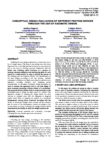
|
Conceptual Design Evaluation of Different Friction Devices Through the Use of Axiomatic Design
Girgenti, Andrea, Alessandro Giorgetti, Cosimo Monti, and Paolo Citti
8th International Conference on Axiomatic Design, 2014
Defining the best design solutions is a current issue for a lot of design teams. This issue is becoming more and more important due to the high standard requested to new products and to the need of meeting customer satisfaction with the lowest cost. Defining critical functions of a product by meeting customer satisfaction and reaching the goals of a new project is a critical activity in order to provide the success of the company and the business efficacy. The identification of the best design, according to the two axioms, permits companies to minimize the high costs related to trial and error approach, avoiding mistakes and designing goods systematically. In this paper Axiomatic Design principles are used to evaluate the agreement level to the best design of some concepts concerning a friction device of a mechanism. The proposed friction devices work to avoid overloads on the mechanism used to release the spare wheel of a vehicle. This approach consists of drawing the design matrix for each concept to compare them with the triangular or diagonal matrix. Such kinds of matrices are typical of a functional independence among critical functions, according with the theory of Axiomatic Design. Each concept will be evaluated also in terms of the information content according to the second axiom, in order to identify the design solution which maximizes the probability to verify the design requirements.
|
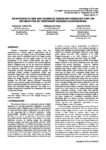
|
An Integrated Qfd and Axiomatic Design Methodology for the Satisfaction of Temporary Housing Stakeholders
Lindsey R. Gilbert III, Mohammed Omar, and Amro M. Farid
8th International Conference on Axiomatic Design, 2014
Modern construction projects must meet the requirements of a diverse range of stakeholders, each of whom have their own unique needs and constraints. Ideally these needs would be identified early in the design process when the designers have the largest impact on cost and functionality of the project. Unfortunately, this stage is typically approached in an informal and non-homogenous manner. Designers often do not use formal and systematic tools until later in the design process. This study proposes a new systematic approach to the conceptual design of construction projects -specifically temporary housing- by combining Quality Function Deployment (QFD) and Axiomatic Design (AD). This combined methodology helps ensure that the design meets customer’s needs, as well as satisfies the design objectives in a logical sequence. More precisely, the QFD-AD method proposed innovatively combines two prevalent design methodologies in a way that allows a seamless translation of diverse customer needs into a formal and methodical design approach. The design of a refugee housing unit is presented as an illustrative case study of temporary housing.
|
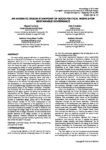
|
An Axiomatic Design Standpoint of Socio-Political Models for Sustainable Governance
Cavique, Miguel, António Gonçalves-Coelho, João Fradinho, and António Mourão
8th International Conference on Axiomatic Design, 2014
The most widely accepted definition of sustainability is the one of the World Commission on Environment and Development (WCED), a. k. a. the Brundtland Commission, which states that the “sustainable development is the development that meets the needs of the present generation without compromising the ability of future generations to meet their own needs”. Accordingly, sustainable development takes into account the population, the economic and the environmental dimensions. Axiomatic Design (AD) allows expressing the many interactions between the aforementioned three concerns that yield to coupled design equations, which may have a higher or a lower degree of complexity depending on the number and on the nature of the requirements. Using the first two dimensions, i.e., the population and the economic ones, we can accomplish design equations that reflect the traditional socio-political shape of the Western civilization. Thereafter, one introduces the third dimension, the environmental one, expanding the design equation by adding the so-called ecorequirements and the related parameters. Doing so, it expresses, or will to express, the shifting from the former sociopolitical ideas about the role of engineering design to the new concept of sustainable design, giving rise to the discussion about different models for the future development of the mankind. One of the objectives of the application of AD to the sustainability problem is to help choosing design solutions with as low complexity as possible. In order to achieve it, one could change the design range of the extant requirements or try different sets of design parameters, as well as freeze some specific elements of the design equation or try redundant design solutions. Different solutions for sustainability may reflect diverse socio-political models of governance, which are also briefly discussed in the paper.
|
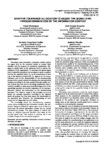
|
Adaptive Tolerance Allocation to Adjust the Sigma Level through Minimization of the Information Content
Henriques, David, António Gonçalves-Coelho, José Gomes Requeijo, and António Mourão
8th International Conference on Axiomatic Design, 2014
Nowadays, mass production companies usually employ the sigma level as the preferred metric to control their activities with the purpose of operational optimization. Sixsigma is usually taken as the minimum level to achieve the excellence of the organization. To increment the global sigma level of assembly operations it is necessary to assure a suitable level for the capability index, Cpk, in the manufacture of each one of the assembly components. Cpk depends on the design tolerances and on the characteristics of the manufacturing process and is usually attained by adjusting the manufacturing variables according to the data acquired through quality control. If these data were sent to the design department, then it would be possible to attain some prescribed sigma level at the assembling operation by selective adaptation of the tolerance allocation, without any intervention on the manufacturing processes. The tolerance values of the complete mechanical system are mutually dependent according to the adopted model of analysis, but they must assure the functionality of the assembled sets. However, the manufacturing of each component is independent from the others.
|
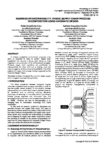
|
Business Interoperability: Dyadic Supply Chain Process Decomposition Using Axiomatic Design
Espadinha-Cruz, Pedro, António Mourão, António Gonçalves-Coelho, and António Grilo
8th International Conference on Axiomatic Design, 2014
In today’s competitive environment, companies must strive to cooperate in order to survive. Supply chain cooperation has become a strong asset relying on large integration and coordination of its well-structured processes. However, supply chain operations are conditioned by interoperability, for which until now is missing a tool that helps managers to identify and solve its problems. This article presents the supply chain process redesign supported by the Axiomatic Design Theory.
|
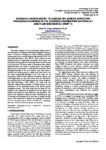
|
Axiomatic Design Model to Assess Influences Affecting Pedagogic-Learning in the Courses Engineering Materials I and Fluid Mechanics I (Part 1)
Mirzi D. Llego-Betasolo
8th International Conference on Axiomatic Design, 2014
This paper explores to set an axiomatic design model in
the Assessment of Influences Affecting Pedagogic-Learning in
order to succeed in finding core factors affecting student’s
performance for the courses Engineering Materials I (CE 221)
and Fluid Mechanics I (CE 211-F). These subjects are the
building blocks of engineering knowledge, thus require that
the student should grasp the knowledge before he/she moves
to the next level. The survey aims to understand what student
influential factor best relate to teacher goals. The questions
asked to get the perception of what influences students’ about
pedagogic-learning on the two subjects were taken from a
inventory of teaching goals by Angelo and Cross (1993). On
the course Engineering Materials I (CE 221), there are 92
second-year students from Mineral Processing, Mining and
Civil Engineering. On the other hand, there are 42 secondyear
students from Civil Engineering for the course Engineering
Fluid Mechanics I (CE 211-F). The study uses the
axiomatic design (AD) principles in finding success on the
assessment of the influential factors that affects student
pedagogic-learning. The study found that by using AD, the
analysis of the assessment is simplified and the factors that
influence the students in each subject are best identified. The
result of the assessment helps the author identifying the gap
of teaching and learning and to find ways to bridge that gap
using a new framework to address the challenges of culturerich
and educational-poor factors of influence in pedagogic
learning. This document is composed by two parts.
|
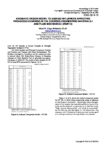
|
Axiomatic Design Model to Assess Influences Affecting Pedagogic-Learning in the Courses Engineering Materials I and Fluid Mechanics I (Part 2)
Mirzi D. Llego-Betasolo
8th International Conference on Axiomatic Design, 2014
This paper explores to set an axiomatic design model in
the Assessment of Influences Affecting Pedagogic-Learning in
order to succeed in finding core factors affecting student’s
performance for the courses Engineering Materials I (CE 221)
and Fluid Mechanics I (CE 211-F). These subjects are the
building blocks of engineering knowledge, thus require that
the student should grasp the knowledge before he/she moves
to the next level. The survey aims to understand what student
influential factor best relate to teacher goals. The questions
asked to get the perception of what influences students’ about
pedagogic-learning on the two subjects were taken from a
inventory of teaching goals by Angelo and Cross (1993). On
the course Engineering Materials I (CE 221), there are 92
second-year students from Mineral Processing, Mining and
Civil Engineering. On the other hand, there are 42 secondyear
students from Civil Engineering for the course Engineering
Fluid Mechanics I (CE 211-F). The study uses the
axiomatic design (AD) principles in finding success on the
assessment of the influential factors that affects student
pedagogic-learning. The study found that by using AD, the
analysis of the assessment is simplified and the factors that
influence the students in each subject are best identified. The
result of the assessment helps the author identifying the gap
of teaching and learning and to find ways to bridge that gap
using a new framework to address the challenges of culturerich
and educational-poor factors of influence in pedagogic
learning. This document is composed by two parts.
|
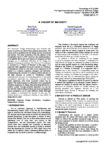
|
A Theory of Maturity
Erik Puik and Darek Ceglarek
8th International Conference on Axiomatic Design, 2014
The ‘Axiomatic Design Methodology’ uses ‘Axioms’ that cannot be proven nor derived from physical phenomena. The axioms serve as guidelines for the design process of products and systems. The latest contribution was the addition of the ‘Complexity Axiom’ in 1999. However, the underlying theory of complexity did not get much traction by designers and their managers yet. It emphasises difficulties in the design, not primarily focussing on solutions. The ‘Theory of Complexity’ is converted to a ‘Theory of Maturity’ in this paper. It is supported with a graphical way to plot maturity as it develops. It visualises the results in a way that can be understood by all entities in a company, engineers, managers, and executives. Understanding the maturity of a system enables selection of the right measures to control it. Visualisation enables communication between the interacting parties. If successful development trajectories are understood, eventually from earlier experience, even better corrective actions can be applied. The method appears an affirmative way to graphically represent progression in design, thus presenting advances in a positive context. Though positively presented, it is not the case that the method hides problems; presumed and legitimate project progression can be quite different, which challenges the designer to understand the process. In this way, the method sends out a continuous warning to stay critical on design choices made.
|
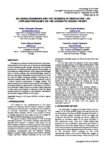
|
Six Sigma Roadmaps and the Degrees Of Innovation – An Explanation Based On the Axiomatic Design Theory
Marques, Pedro Alexandre, Pedro Manuel Saraiva, José Gomes Requeijo, and Francisco Frazão Guerreiro
8th International Conference on Axiomatic Design, 2014
Six Sigma is a customer-focused, data-driven, and projectbased approach that makes use of structured methodologies to drive business success through improving the functional performance of existing products, services and processes, or by creating new design solutions. All Six Sigma methodologies rely on a certain roadmap with well-defined stages, where for each one clear goals, deliverables, and outcomes are set. There are many Six Sigma roadmaps available. Knowing this, an important question arises: which Six Sigma roadmap to use in a certain continual improvement or design project? The answer depends on the project scope, namely in the degree of innovation inherent to such project. In this paper, we do show how Axiomatic Design Theory can provide a useful reasoning to help project team leaders to determine which Six Sigma roadmap should be employed in each situation, attending to the innovation degree inherent to the project.
|
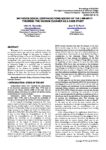
|
Methodological Contradictions Solved By the Linearity Theorem: The Vacuum Cleaner as a Case Study
Efrén M. Benavides and Joan B. R. Pastor
8th International Conference on Axiomatic Design, 2014
This paper is the continuation of a previous one where the vacuum cleaner was used as an academic example for teaching Conceptual Design. In this paper the example is extended by including the use of the Linearity Theorem as a screening tool that allows the student to select the best configuration. The paper shows several contradictions that arise when students have to face design problems with the use of Axiomatic Design in a qualitative way. In particular, ambiguities derived from the individual or sequential application of the Axioms are described. The Linearity Theorem is proposed as a powerful tool for applying both Axioms at the same time and hence for overcoming the difficulties associated to the aforementioned contradictions.
|

|
Axiomatic Design as a Consultancy Tool in Product Design
Joan B. Rodríguez and Efrén M. Benavides
8th International Conference on Axiomatic Design, 2014
The practice of innovation and technological advising demands from consultancy companies the ability to propose consistent solutions to their customers’ challenges. This paper explores the use of Axiomatic Design as a consultancy tool by Altran group, and how the unequivocal definition of optimal design given by the axioms constitutes a high-value for strategic decisions. More specifically, from the methodological research carried on in collaboration with the School of Aeronautics of Universidad Politécnica de Madrid, this work presents how Axiomatic Design has been used to advise Altran clients in innovation and improvement challenges, focusing on the lessons learnt by applying it to product design. Additionally, the discussion presents the main difficulties and benefits found on the aforementioned applications.
|
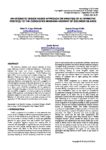
|
An Axiomatic Design Based Approach on Analysis of Alternative Route(S) to the Congested Mendana Highway of Solomon Islands
Llego-Betasolo, Mirzi D., Jayson George Hallu, and Justin Kubul
8th International Conference on Axiomatic Design, 2014
The Solomon Islands road network consists of three major highways, Kukum, Tandai and Mendana. The Kukum highway has major and minor un-signalized junction, overhead pass, and a dual carriageway. Tandai Highway has light traffic, minor junction and a single carriage way. The Mendana Highway has major & minor un-signaled junction, roundabout, underpass, and dual carriageway. Of the three highways, Mendana undergoes the most traffic congestion at Honoria section because of the high demand of the road use to access the basic services whilst vehicle increases and uses on a fewer road availability competing with the pedestrian users. The paper discusses on how to find alternative route to ease the traffic congestion of existing highway by axiomatic design (AD) approach contributing to the over-all analysis of process to determine which alternative route is the best viable. Selection of alternative route is a complex process and the application of AD is found to simplify the overall analysis.
|
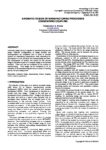
|
Axiomatic Design of Manufacturing Processes Considering Coupling
Brown, Christopher A.
8th International Conference on Axiomatic Design, 2014
Axiomatic design theory is applied to manufacturing process design. Different configurations of design domains and decompositions are considered here in order to provide options for maintaining independence while addressing the development of new products and manufacturing processes. The development of metrics and criteria for the process design is described as part of a complete design of the process variables. Value and cost are considered in the context of manufacturing. Tool design can be considered to be an extension of the manufacturing process as a means of meeting special, new processing needs.
|
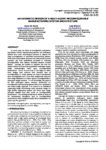
|
An Axiomatic Design of a Multi-Agent Reconfigurable Manufacturing System Architecture
Amro M. Farid and Luis Ribeiro
8th International Conference on Axiomatic Design, 2014
In recent years, the fields of reconfigurable manufacturing
systems, holonic manufacturing systems, and multi-agent
systems have made technological advances to support the
ready reconfiguration of automated manufacturing systems.
While these technological advances have demonstrated robust
operation and been qualitatively successful in achieving
reconfigurability, their ultimate industrial adoption remains
limited. Amongst the barriers to adoption has been the
relative absence of formal and quantitative multi-agent system
design methodologies based upon reconfigurability
measurement. Hence, it is not clear 1.) the degree to which
these designs have achieved their intended level of
reconfigurability 2.) which systems are indeed quantitatively
more reconfigurable and 3.) how these designs may overcome
their design limitations to achieve greater reconfigurability in
subsequent design iterations. To our knowledge, this paper is
the first multi-agent system reference architecture for
reconfigurable manufacturing systems driven by a quantitative
and formal design approach. It is rooted in an established
engineering design methodology called axiomatic design for
large flexible engineering systems and draws upon design
principles distilled from prior works on reconfigurability
measurement. The resulting architecture is written in terms of
the mathematical description used in reconfigurability
measurement which straightforwardly allows instantiation for
system-specific application.
|
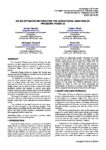
|
An Ad Optimized Method for the Structural Analysis of Pressure Vessels
Girgenti, Andrea, Alessandro Giorgetti, Cosimo Monti, and Paolo Citti,
8th International Conference on Axiomatic Design, 2014
The Axiomatic Design theory allows finding the right solutions in order to respond to functional needs of a product. Adopting the best solution is important in order to avoid a non-optimal design that can result in losses of time and money. Axiomatic Design theory (or simpler AD theory) may concern not just the design of a product but it can also deal with defining processes or tools. The usage of the most efficient and effective tools is a more and more important issue in engineering activities in order to achieve results with short times and optimized resources and funds. From this point of view the Axiomatic Design theory can be used in order to select the proper calculation method that permits to achieve these goals. Pressure vessels are quite common parts in several machines or plants, usually they present round bottoms but sometimes a flat bottom is required to minimize their sizes. The scope of this paper is to introduce an optimized AD calculation method in order to perform structural analysis of a pressure vessel with a lower planeside and several reinforcements. Two methods may be used to solve the structural issue. They will be introduced in the following passages. Their design matrices, according with the first axiom, will be found and on the basis of these matrices a comparison between these approaches will be carried out.
|
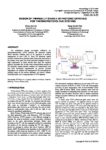
|
Design of Thermally Stabile 2d Photonic Crystals for Thermophotovoltaic Systems
Heon Ju Lee and Sang-Gook Kim
8th International Conference on Axiomatic Design, 2014
For maximized energy conversion efficiency on thermophotovoltaic (TPV) systems, 2D photonic crystal (PhC) selective emitters have to be operated at elevated temperature of over 1100 oC. Since 2D photonic crystal selective emitters have periodic micro/nano-scale structures at the surface, they easily lose their structural integrity at such a high temperature in much shorter time than the required system’s operation life. In this work, thermal failure modes of 2D photonic crystal selective emitters are characterized and top level functional requirements to prevent thermal degradation are defined and decomposed. By uncoupling the coupled nature of the surface diffusion, we found a system thermally stable over a long operation of TPV systems.
|
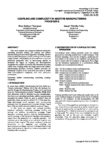
|
Coupling and Complexity in Additive Manufacturing Processes
Mary Kathryn Thompson and Joseph Timothy Foley
8th International Conference on Axiomatic Design, 2014
This work analyzes and compares traditional subtractive machining processes (milling and turning) and additive manufacturing processes (fused deposition modeling, selective sintering, stereolithography, and 3D printing) in an Axiomatic Design context. The processes are examined from a local and isothermal perspective then as time-varying systems to determine the degree of coupling and time-dependent complexity they exhibit. It is shown that subtractive processes exhibit more coupling within the design matrix than additive manufacturing processes. However, additive processes are intrinsically coupled at the voxel level and seem to exhibit more time-dependent complexity than their subtractive counterparts.
|
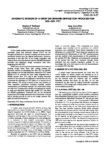
|
Axiomatic Design of a Drop on Demand Deposition Process for Sol-Gel Pzt
Stephen P Bathurst and Sang Gook Kim
8th International Conference on Axiomatic Design, 2014
Of the readily available piezoelectric engineering materials perovskite phase lead zirconate titanate (PZT) has the strongest mechanical to electrical coupling and allows electromechanical devices have the highest performance. However, processing of thin film PZT is not readily compatible with existing micro-electromechanical systems (MEMS) fabrication processes and significant design constraints exist when integrating thin film PZT. While some recent work has demonstrated novel ways of forming sol-gel based films, spin coating remains the dominant method of depositing thin film PZT for MEMS. Spin coating is not the best fabrication method for PZT based MEMS but it is currently the most easily integrated into a MEMS process flow. Not only is spin coating inherently wasteful of the expensive and difficult to manufacture sol, but it prevents the deposition of PZT films on or around out of plane features. The sol-gel material is also very sensitive to other deposition parameters including humidity, particle contamination, and substrate material. As a result device yields are often low. Consequently a flexible new approach is needed to easily and effectively deposit high quality PZT thin films for MEMS applications. Presented here are the functional requirements and design parameters that characterize a sol-gel ink jet printing process as well as the design matrices that guide successful development.
|
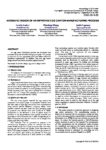
|
Axiomatic Design of an Improved Egg Carton Manufacturing Process
Kudzal, Andelle, Zhaolong Zhang, and Justin Lagassey
8th International Conference on Axiomatic Design, 2014
An egg carton fabrication process was developed and evaluated using the Axiomatic Design principles. The process is improved via new approaches that could better match the functional requirements. In addition, this new egg carton design should have better protection against bacteria.
|